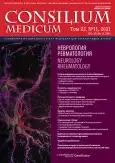Parsonage–Turner recurrent acute idiopatic neuralgic amyotrophy case. Case report
- Authors: Kovrazhkina E.A.1, Abramova T.A.1, Serdyuk A.V.2, Lelyuk V.G.1
-
Affiliations:
- Federal Center of Brain Research and Neurotechnologies
- Pirogov Russian National Research Medical University
- Issue: Vol 23, No 11 (2021)
- Pages: 879-883
- Section: Articles
- URL: https://journals.rcsi.science/2075-1753/article/view/96631
- DOI: https://doi.org/10.26442/20751753.2021.11.201158
- ID: 96631
Cite item
Full Text
Abstract
Recurrent Parsonage–Turner syndrome is a hereditary form of a syndrome from neuralgic amyotrophic group, with a characteristic clinical picture in the form of severe pain syndrome with remission and subsequent development of upper shoulder girdle atrophy, proceeding with the accumulation of neurological deficit. Despite the characteristic clinical picture, the syndrome requires a differential diagnosis with a number of conditions, in which electroneuromyography helps along with other techniques. Wherein neuropathic sings of the upper extremity nerves are usually detected, and the long thoracic and suprascapular nerves are most often affected, at that more often by axonopathic type. Electromyography reveals denervation sings in the upper brachial muscles. This article describes Parsonage–Turner recurrent acute neuralgic amyotrophy case, discusses the issues of the clinical picture, diagnosis and treatment of this disease.
Full Text
##article.viewOnOriginalSite##About the authors
Elena A. Kovrazhkina
Federal Center of Brain Research and Neurotechnologies
Email: elekov2@yandex.ru
ORCID iD: 0000-0002-2898-8968
Cand. Sci. (Med.)
Russian Federation, MoscowTatiana A. Abramova
Federal Center of Brain Research and Neurotechnologies
Email: abramova2110tatiana@gmail.com
ORCID iD: 0000-0001-5787-5172
functional diagnostics doctor
Russian Federation, MoscowAnna V. Serdyuk
Pirogov Russian National Research Medical University
Author for correspondence.
Email: aserdyuk@gmail.com
ORCID iD: 0000-0002-9287-966X
Cand. Sci. (Med.)
Russian Federation, MoscowVladimir G. Lelyuk
Federal Center of Brain Research and Neurotechnologies
Email: v.g.lelyuk@gmail.com
ORCID iD: 0000-0002-9690-8325
D. Sci. (Med.), Prof.
Russian Federation, MoscowReferences
- Parsonage MJ, Turner JW. Neuralgic amyotrophy: the shoulder-girdle syndrome. Lancet. 1948;1(6513):973-8. doi: 10.1016/s0140-6736(48)90611-4
- Misamore GW, Lehman DE. Parsonage-Turner syndrome (acute brachial neuritis). J Bone Joint Surg Am. 1996;78(9):1405-8. doi: 10.2106/00004623-199609000-00018
- Van Ejik JJ, Groothuis JT, Van Alfen N. Neuralgic amyotrophy: an update of diagnosis, pathophysiology and treatment. Muscle Nerve. 2016;53(3):337-50. doi: 10.1002/mus.25008
- Хайбуллин Т.И., Гранатов Е.В., Аверьянова Л.А., Бабичева Н.Н. Невралгическая амиотрофия плечевого пояса. Практическая медицина. 2013;1(66):42-9 [Khaibullin TI, Granatov EV, Averyanova LA, Babicheva NN. Neuralgic amyotrophy of shoulder girdle. Prakticheskaia meditsina. 2013;1(66):42-9 (in Russian)].
- Бушкова Ю.В., Стаховская Л.В., Ковражкина Е.А., Шурдумова М.Х. Острая идиопатическая невралгическая амиотрофия: синдром Персонейджа–Тернера. Consilium Medicum. 2018;20(2):78-83 [Bushkova YuV, Stakhovskaya LV, Kovrazhkina EA, Shurdumova MKh. Idiopathic neuralgic amyotrophy: Parsonage–Turner syndrome. Consilium Medicum. 2018;20(2):78-83 (in Russian)]. doi: 10.26442/2075-1753_2018.2.78-83
- Feinberg JH, Radecki J. Parsonage-Turner Syndrome. HSS J. 2010;6(2):199-205. doi: 10.1007/s11420-010-9176-x
- Мозолевский Ю.В., Ахмеджанова Л.Т., Суслова Е.Ю. Рецидивирующая невралгическая амиотрофия плечевого пояса. Неврологический журнал. 2014;1:38-43 [Mozolevskiy YuV, Akhmedzhanova LT, Suslova EYu. Recurrent neuralgic amyotrophy of shoulder girdle. Nevrologicheskii zhurnal. 2014;1:38-43 (in Russian)].
- Feinberg JH, Nguyen ET, Boachie-Adjei K, et al. The electrodiagnostic natural history of parsonage-turner syndrome. Muscle Nerve. 2017;56(4):737-43. doi: 10.1002/mus.25558
- Nagano A. Spontaneous anterior interosseous nerve palsy. J Bone Joint Surg Br. 2003;85(3):313-8. doi: 10.1302/0301-620x.85b3.14147
- Nagano A, Shibata K, Tokimura H, et al. Spontaneous anterior interosseous nerve palsy with hourglass-like fascicular constriction within the main trunk of the media nerve. J Hand Surg Am. 1996;21(2):266-70. doi: 10.1016/S0363-5023(96)80114-6
- Devathasan G, Tong HI. Neuralgic amyotrophy: criteria for diagnosis and a clinical with electromyographic study of 21 cases. Aust N Z J Med. 1980;10:188-91. doi: 10.1111/j.1445-5994.1980.tb03711.x
- Fibuch EE, Mertz J, Geller B. Postoperative onset of idiopathic brachial neuritis. Anesthesiology. 1996;84:455-8. doi: 10.1097/00000542-199602000-00028
- McCarty E, Tsairis P, Warren R. Brachial neuritis. Clin Orthop Relat Res. 1999;(368):37-43.
- Широков В.А., Кудрявцева М.С. Болевые синдромы плечевого пояса: диагностика и лечение. Медицинский портал для врачей. Режим доступа: http://www.umedp.ru/articles/bolevye_sindromy_plechevogo_poyasa_diagnostika_i_lechenie.html. Ссылка активна на 26.08.2021 [Shirokov VA, Kudriavtseva MS. Bolevye sindromy plechevogo poiasa: diagnostika i lechenie. Meditsinskii portal dlia vrachei. Available at: http://www.umedp.ru/articles/bolevye_sindromy_plechevogo_poyasa_diagnostika_i_lechenie.html. Accessed: 26.08.2021 (in Russian)].
- Misamore GW, Lehman DE. Parsonage-Turner syndrome (acute brachial neuritis). J Bone Joint Surg Am. 1996;78(9):1405-8. doi: 10.2106/00004623-199609000-00018
- Watson CP, Babul N. Efficacy of oxycodone in neuropathic pain: a randomized trial in postherpetic neuralgia. Neurology. 1998;50:1837-41. doi: 10.1212/wnl.50.6.1837
Supplementary files









